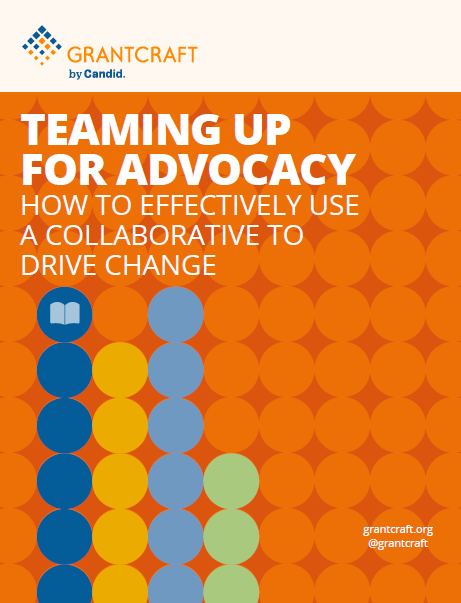Funder Advocacy Collaboratives: Framing Thoughts
Editor’s Note: This article is the first in a resource series about funder advocacy collaboratives. The series draws on real-world funder experiences to share strategies about anticipating and overcoming prevalent obstacles to success. See Acknowledgements and Methodology and our series content page for more background.
“Funders need to collaborate more.” How many times have we heard that?
The good news: Funders are collaborating more. Today, there are all kinds of learning networks, aligned funding and strategy associations, affinity groups, and other structures that are making it easier for grantmakers to collaborate.
Many funders, however, are still apprehensive about funding advocacy. A Foundation Center analysis of a sample of the largest funders demonstrates that only 12.8 percent of overall foundation grantmaking explicitly supports policy, advocacy, and systems reform. The Atlantic Philanthropies observes that advocacy funding is too often “the philanthropic road not taken, yet it is a road most likely to lead to the kind of lasting change that philanthropy has long sought through other kinds of grants.”
It’s an easy road to avoid. Publicly taking a stand on controversial issues can be dicey for foundation leaders, and supporting advocacy can be complex, time-intensive, and risky. Stir the varied interests, goals, and personalities of a diverse group of funders into the mix and it becomes even more daunting.

Given the deepening concern—and increasing activism—sparked by the recent change of administration in the U.S., that may be changing. Wherever you stand on the issues, it is hard to ignore the dramatic upswing in advocacy activity since the election. Some of it involves collaboratives successfully bringing together funders to advance important issues through public policy campaigns, communications, research, and strategic grantmaking. And they are getting results, despite the obstacles in their way.
If we are to overcome the inevitable concerns about joining an advocacy collaborative and understand what makes them successful, we need to ask: What distinguishes an advocacy collaborative from other kinds of collaboratives? For an answer, we spoke with several advocacy collaborative stakeholders. This is what we heard:
- Advocacy collaboratives focus on very specific goals. Advocacy funders are very clear about the policy change, reform, or institution they want to see. “The best policy collaboratives are laser-focused on very clear goals that everyone agrees on. They then analyze how and where that needs to happen, figure out what a nonprofit organization can do, and then put their funding behind it. In my opinion, if you don’t do that, you’re not a policy funder.” That kind of focus “creates a sense of urgency about the work that encourages people to leave their organizational hats at the door and all work on the same team.”
- They flex and adapt. Many funder advocacy collaboratives allocate at least part of their resources to providing rapid-response grants that move money out to groups on the ground in a timely fashion. “Our foundation had been giving long-term core support to some big national groups that were steeped in our issue. But we wanted to give more reactive, project-oriented money to organizations on the front lines on a much quicker timeline and at a much quicker pace. That’s why we joined this kind of collaborative—it can do that.”Policy advocacy collaboratives also continually tweak their strategies to align with the changing political, economic, and social context. “In advocacy collaboratives, funders have to have a shared vision of what they’re trying to achieve, even if they have to refine their strategies every six months. In other collaboratives with less pressing issues, there’s no deadline, and you can lose focus or drift along. They’re then more likely to become social centers for donors, rather than promoting advocacy for social change.”
- They offer support for capacity and field building. Campaigns and policy wins are great, but they’re just part of the equation in these kinds of collaboratives. “It’s equally important to build the capacity of the organizations on the ground as it is to build the field overall so there’s a strong infrastructure created that’s not only able to react to policy-related opportunities when they emerge but also anticipate future opportunities.” In short, “You can have a bunch of policy wins, but if there’s no infrastructure to support the work going forward, it won’t have as much impact.”
- They embrace complexity. Advocacy and organizing cut across lots of issues, but foundations still tend to be rooted in siloed program areas. That can make it difficult to figure out where or how each funder can make advocacy and organizing work for them and their institution. “An LGBT funder joined our immigration rights collaborative because they understood how immigration reform affects their constituency. That’s not the usual case, because most funders work in specific program areas and can’t always see how their policy issues affect their institution’s other program areas—not just one.” And even when they do see it, the way their institutions are set up sometimes doesn’t allow for this kind of cross-cutting grantmaking.There are also different kinds of advocacy collaboratives. Some provide efficient vehicles for funders who don’t have the staff capacity to do these kinds of grants and can “help get resources into the field more efficiently, strategically, and responsively.” Some come together when there’s a crisis with the sole purpose of being a “rapid response” mechanism for moving money out the door quickly to organizations that need it. Some just support research on an issue rather than organizing around it. And still others operate almost like a foundation by making grants through a pooled fund.
- They acknowledge and embrace risk. Advocacy collaborative funders accept that the work is inherently risky. “Our collaborative spent years supporting a major federal-level reform policy, and we lost. That was a huge blow that no one saw coming. All this money went into that strategy, and we got it wrong. Fortunately, the funders in the collaborative understood that you win some and you lose some—and their institutions understood that as well.” Part of the risk is that a lot of this work plays out over the long term. “Policy change takes time, and many foundations aren’t able or willing to stay the course that long. They get nervous when there aren’t immediate ‘outcomes’.”
If those are some of the ways in which funder advocacy collaboratives differ from other kinds of collaboratives, what makes them successful? And how can grantmakers make sure that the considerable investments of time and money these efforts require pay off?
Those were questions GrantCraft posed to several grantmakers and grantees with deep experience as participants in advocacy collaboratives. We asked them to identify the challenges they typically faced and to provide some tips and stories that could help their peers navigate and overcome the tough stuff and maximize the potential for success.
And they delivered.
Our research surfaced a number of ways to overcome the inevitable sticking points that can torpedo even the best-planned collaborative policy initiative—things like groupthink and what to do when there’s disagreement about where and how funds should be allocated. Interviewees also offered some frank advice for grantmakers involved in these collaboratives when they get pushback from their institutions about that participation.
Respondents also laid out the benefits of these kinds of collaboratives and shared their insights to what makes them successful, including ways to get consensus on strategy—and what to do if that doesn’t happen.
Structural issues are also important. Not the least of these are the tensions that can bubble up between big funders and smaller ones and whether and how to employ intermediaries or other kinds of external support. Respondents were particularly interested in how this work could be done in ways that engage grantees more as partners — rather than beneficiaries.
The insights noted above only scratch the surface of the practical wisdom and key findings we’ve collected, and we’re sharing it with you as short pieces that make it easy to learn, reflect, and share. We’ve also pulled together what we believe to be some of the most useful publications, research, tools, and other materials on the topic at fundingadvocacy.issuelab.org.
As you prepare to dig into this series and its lessons, we want to leave you with two of our most important takeaways from the research:
First, funders who are part of advocacy collaboratives tend to be fierce believers in their collective power, especially in moving the needle on big, often controversial, issues. Many foundations have historically shied away from such issues, but the tide seems to be turning. Today, we’re seeing more interest by grantmakers in joining these kinds of collaboratives, which we suspect has a lot to do with a growing awareness of the impact policy advocacy work has had on issues as varied as public education reform, tax reform, the death penalty, gay marriage, and gun violence.
Second (and as noted above), a significant number of advocacy collaborative grantmakers said they were becoming more interested in finding ways to engage with grantees as partners, rather than as beneficiaries, in strategy development, field building, and even grant decisions. This trend not only reflects larger cultural shifts that, in part thanks to technology, have given people the power to participate more directly in everything from crowdfunding to online organizing, it also is a powerful and cost-effective way to walk the talk of social justice.
The series is intended for both seasoned funders looking to troubleshoot and strengthen work they’re doing in an existing advocacy collaborative, as well as funders thinking of dipping their toes in the water. We included reflection questions to allow you to apply these lessons to your own work. And we developed a decision-making tree to aid the start-up process for prospective advocacy collaboratives. Let us know how you use the materials or if you have other resources to share.
Please click here for information on GrantCraft’s methodology for this research, and/or dig into the series through the connected content below.
(Photo: Michael Coghlan, licensed under CC BY-SA 2.0)



